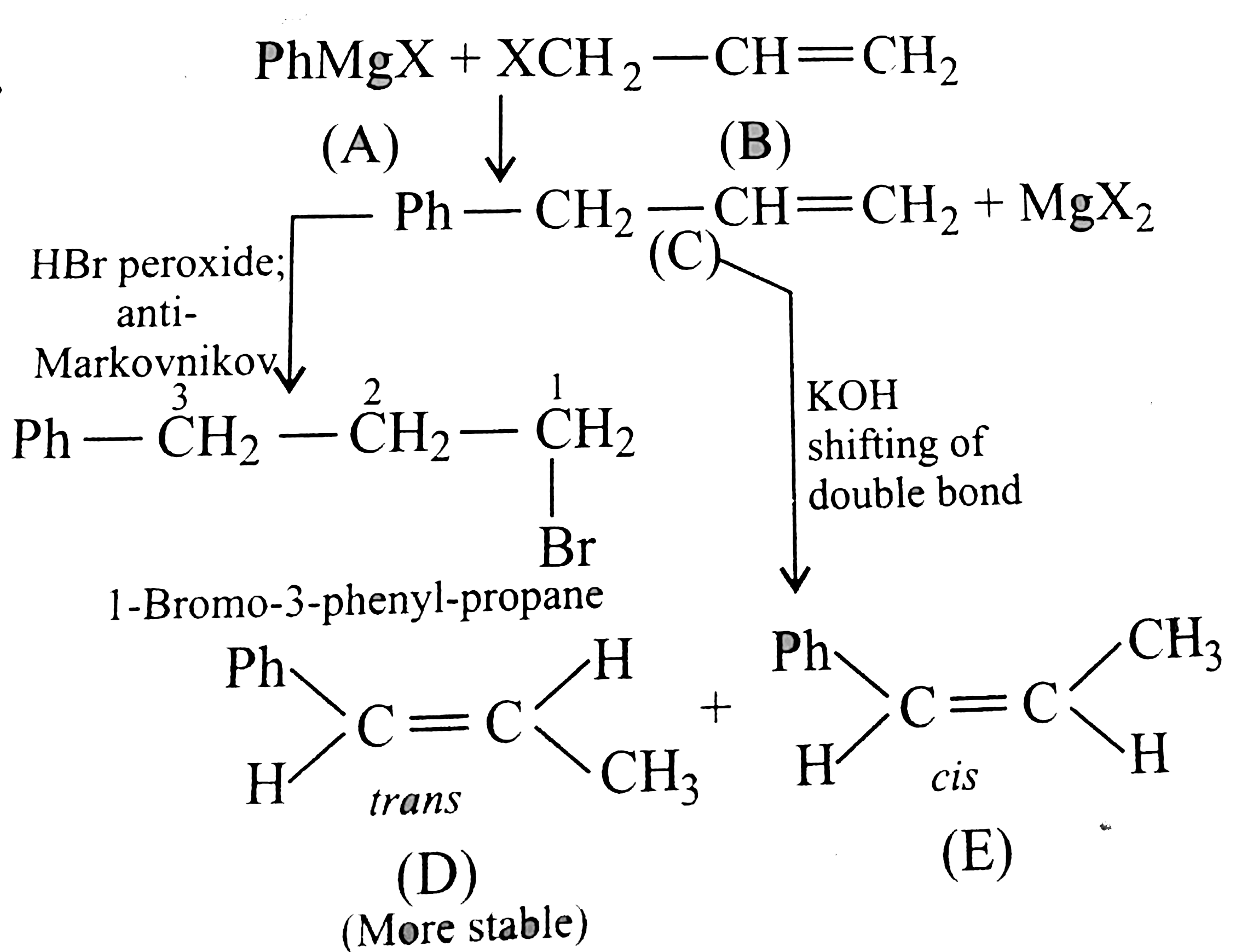A Grignard regane t(A0 and a haloalkene (B) react together to give (C) compound (C) on heating with KOH yields a mixture of two geometrical isomers, (D) and (E) of which (D) predominates. (C) gives 1− bromo 3− phenyl propane on reaction with Hbr in the presence of a peroxide. Give teh structures of (A),(B), and (C) and the configuratins of (D) and (E).
Topper's Solved these Questions
- AROMATIC COMPOUNDS AND ALKYL AND ARYL HALIDES BOOK - CENGAGE CHEMISTRY ENGLISHCHAPTER - AROMATIC COMPOUNDS AND ALKYL AND ARYL HALIDES EXERCISE - Solved Problems
37 Videos
- AROMATIC COMPOUNDS AND ALKYL AND ARYL HALIDES BOOK - CENGAGE CHEMISTRY ENGLISHCHAPTER - AROMATIC COMPOUNDS AND ALKYL AND ARYL HALIDES EXERCISE - Exercises Subjective Type
5 Videos
- AROMATIC COMPOUNDS AND ALKYL AND ARYL HALIDES BOOK - CENGAGE CHEMISTRY ENGLISHCHAPTER - AROMATIC COMPOUNDS AND ALKYL AND ARYL HALIDES EXERCISE - Archives Subjective Type
4 Videos
- APPENDIX INORGANIC VOLUME 2BOOK - CENGAGE CHEMISTRY ENGLISHCHAPTER - APPENDIX INORGANIC VOLUME 2EXERCISE - Short Answer Type
179 Videos
- BIOMOLECULESBOOK - CENGAGE CHEMISTRY ENGLISHCHAPTER - BIOMOLECULESEXERCISE - Exercises Archives (Analytical And Descriptive)
8 Videos
Similar Questions
A Grignard reagent (A) and a haloalkene (B) react together to give (C). Compound (C) on heating with KOH yields a mixture of two geometrical isomers, (D) and (E), of which (D) predominates. (C) and (E) have the same molecular formula and (C) gives 1-bromo-3-phenyl propane on reaction with HBr in the presence of a peroxide. Give structures of (A), (B)and (C) and configuration of (D) and (E) with reasons.
View SolutionA Grignard reagent (A) and a haloalkene (B) react together to give (C) . Compound (C) on heating with KOH yeilds a mixture of two geometrical isomers (D) and € of which (D) predominates . Compound (C) on reaction with HBr in presence of a peroxide gives 1-bromo-3- phenylpropane. Give the structures of (A), (B) and (C) and configurations of (D) and (E).
View SolutionTwo diffeent Grignard reagents (A) and (B) give the product 2-methyl-1-phenylpropan-2-ol (X) on reaction with (C ) and (D ) respectively. Give the structures of (A),(B),(C ) and (D).
View SolutionCyclopentane on heating with bromine gives compound (A) which on reaction with sodium ethoxide in ethanol, gives (B), Compound (B) on reaction with NBS in presence of peroxide gives (C) .Identify (A), (B) and (C) .
View SolutionDehydrobromination of compounds (A) and (B) yield the same alkene (C). Alkene (C) can regenerate (A) and (B) by the addition of HBr in the presence and absence of peroxide respectively. Hydrolysis of (A) and (B) give isomeric products (D) and (E) respectively. 1, 1-Diphenylethane is obtained on reaction of (C) with benzene in presence of H+. Give structures of (A) to (E) with reasons.
View SolutionDehydrobromination of compounds (A) and (B) yield the same alkene (C). Alkene (C) can regenerate (A) and (B) by the addition of HBr in the presence and absence of peroxide respectively. Hydrolysis of (A) and (B) give isomeric products (D) and (E) respectively. 1, 1-Diphenylethane is obtained on reaction of (C) with benzene in presence of H+. Give structures of (A) to (E) with reasons.
View SolutionDehydrobromination of compounds (A) and (B) yield the same alkene (C). Alkene (C) can regenerate (A) and (B) by the addition of HBr in the presence and absence of peroxide respectively. Hydrolysis of (A) and (B) give isomeric products (D) and (E) respectively. 1, 1-Diphenylethane is obtained on reaction of (C) with benzene in presence of H+. Give structures of (A) to (E) with reasons.
View SolutionAn organic compound (A) (C6H10O) on reaction with CH3MgBr followed by acid treatment gives compound (B). The compound (B) on ozonolysis gives compound (C ), which in the presence of a base gives 1-acetyl cyclopentene (D). The compound (B) on reaction with HBr gives compound (E ). Write the structures of (A), (B), (C ), (D), and (E ). Show how (D) is formed from (C ).
View SolutionAn organic compound (A) (C6H10O) on reaction with CH3MgBr followed by acid treatment gives compound (B). The compound (B) on ozonolysis gives compound (C ), which in the presence of a base gives 1-acetyl cyclopentane (D). The compound (B) on reaction with HBr gives compound (E ). Write the structures of (A), (B), (C ), (D), and (E ). Show how (D) is formed from (C ).
View SolutionAn organic compound (A) (C6H10) on reaction with CH3MgBr followed by acid treatment gives compound (B). The compound (B) on ozonolysis gives compound (C ), which in the presence of a base gives 1-acetylcyclo-pentene (D). The compound (B) on reaction with HBr gives (E ). Write the structures of (A), (B), (C ), and (E). Show how (D) is formed form (C ).
View Solution

